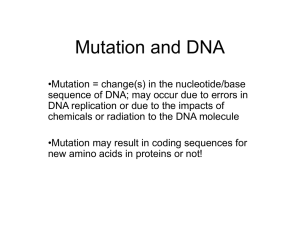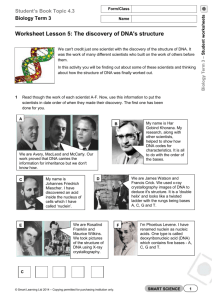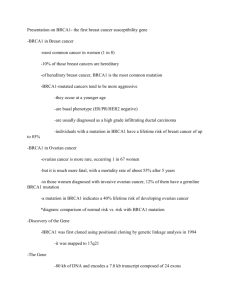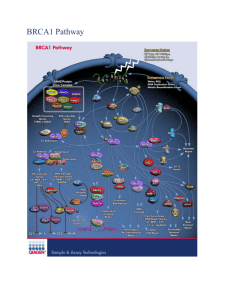Molecular Modeling_Student Worksheet
advertisement
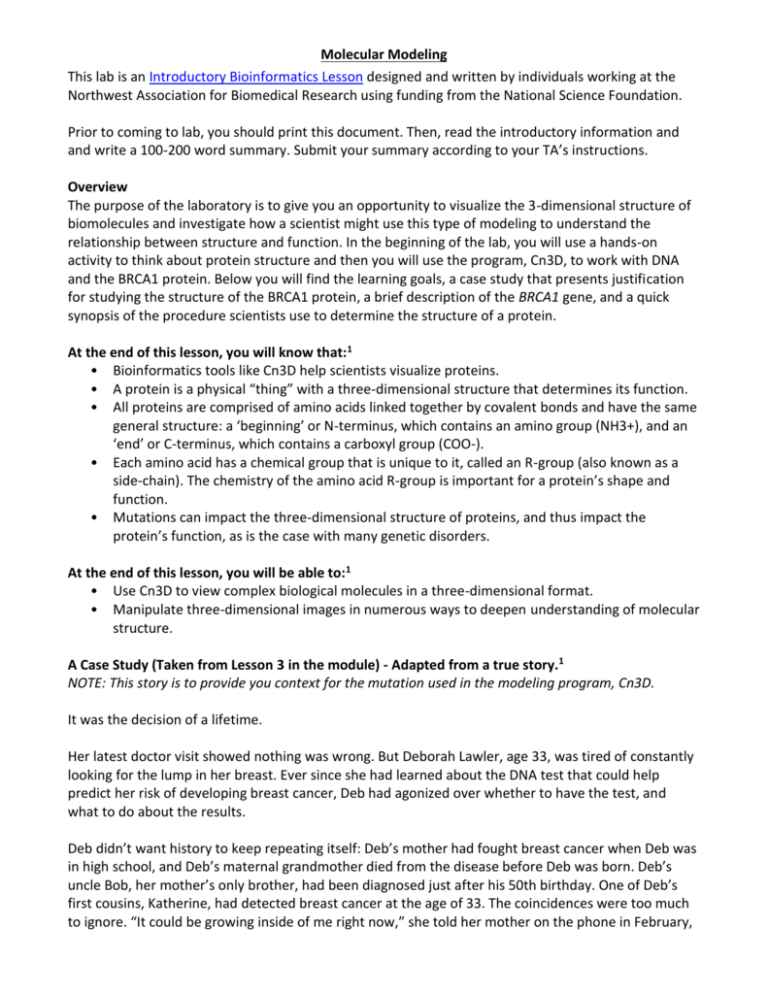
Molecular Modeling This lab is an Introductory Bioinformatics Lesson designed and written by individuals working at the Northwest Association for Biomedical Research using funding from the National Science Foundation. Prior to coming to lab, you should print this document. Then, read the introductory information and and write a 100-200 word summary. Submit your summary according to your TA’s instructions. Overview The purpose of the laboratory is to give you an opportunity to visualize the 3-dimensional structure of biomolecules and investigate how a scientist might use this type of modeling to understand the relationship between structure and function. In the beginning of the lab, you will use a hands-on activity to think about protein structure and then you will use the program, Cn3D, to work with DNA and the BRCA1 protein. Below you will find the learning goals, a case study that presents justification for studying the structure of the BRCA1 protein, a brief description of the BRCA1 gene, and a quick synopsis of the procedure scientists use to determine the structure of a protein. At the end of this lesson, you will know that:1 • Bioinformatics tools like Cn3D help scientists visualize proteins. • A protein is a physical “thing” with a three-dimensional structure that determines its function. • All proteins are comprised of amino acids linked together by covalent bonds and have the same general structure: a ‘beginning’ or N-terminus, which contains an amino group (NH3+), and an ‘end’ or C-terminus, which contains a carboxyl group (COO-). • Each amino acid has a chemical group that is unique to it, called an R-group (also known as a side-chain). The chemistry of the amino acid R-group is important for a protein’s shape and function. • Mutations can impact the three-dimensional structure of proteins, and thus impact the protein’s function, as is the case with many genetic disorders. At the end of this lesson, you will be able to:1 • Use Cn3D to view complex biological molecules in a three-dimensional format. • Manipulate three-dimensional images in numerous ways to deepen understanding of molecular structure. A Case Study (Taken from Lesson 3 in the module) - Adapted from a true story.1 NOTE: This story is to provide you context for the mutation used in the modeling program, Cn3D. It was the decision of a lifetime. Her latest doctor visit showed nothing was wrong. But Deborah Lawler, age 33, was tired of constantly looking for the lump in her breast. Ever since she had learned about the DNA test that could help predict her risk of developing breast cancer, Deb had agonized over whether to have the test, and what to do about the results. Deb didn’t want history to keep repeating itself: Deb’s mother had fought breast cancer when Deb was in high school, and Deb’s maternal grandmother died from the disease before Deb was born. Deb’s uncle Bob, her mother’s only brother, had been diagnosed just after his 50th birthday. One of Deb’s first cousins, Katherine, had detected breast cancer at the age of 33. The coincidences were too much to ignore. “It could be growing inside of me right now,” she told her mother on the phone in February, pacing in the living room of her Chicago apartment. “We could find it any time.” Waiting for an encouraging word, she added, “I could take the test this week.” Her mother, not sure what to say, remained silent. Deb was referring to the breast cancer susceptibility tests—the BRCA tests. Doctors would isolate DNA from Deb’s blood and sequence the Breast Cancer Susceptibility 1 and 2 genes to determine whether known cancer-causing mutations are present. BRCA1 and BRCA2 mutations account for about 5% of all breast cancer. The remaining cases are caused by mutations in other genes, environmental exposures, and other unknown factors. Factors such as excess weight, lack of exercise, having her first period at a young age, and not having children can increase the risk of breast cancer in all women. If the test finds that Deb carries a cancer-causing mutation in her BRCA genes, her risk of breast cancer would increase dramatically – from 12% (the average lifetime risk for all women) to anywhere between 50-85%. A mutation would also increase her risk of ovarian cancer from the average of 2% to between 16-60%. Few things in biology are 100%. BRCA 1 protein2 NOTE: This short paragraph is to provide you a brief description of the protein you will visualize. The gene for this protein is called breast cancer 1, early onset; the protein’s role in the cell is to repair damage to the DNA. BRCA1 does not do this job alone, rather it works with other proteins in the cell to fix the damage and prevent cells from dividing uncontrollably. Certain mutations in this gene can result in a dysfunctional BRCA1 protein. When this protein is not working properly, there is an increased chance that cell division will occur too rapidly or in an uncontrolled way. One outcome of this uncontrolled growth is the formation of a cancerous tumor. Protein Structures (Taken from Lesson 5 in the module)1 NOTE: This paragraph briefly describes how scientists determine the structure you will visualize. Scientists know what DNA, a protein, or other macromolecules look like by using a number of different tools, including X-ray crystallography and nuclear magnetic resonance (NMR), to determine molecular structures. In the case of x-ray crystallography, proteins are crystallized before being bombarded with x-rays. By measuring how the crystals deflect or diffract the x-rays, scientists can determine or “solve” the protein’s structure. With NMR, molecules are subjected to a strong magnetic field that causes the natural magnets in atomic nuclei to spin in the same direction, just like iron filings line up in the presence of a magnet. Radio waves are used to disrupt this state and scientists measure how each atom responds. The characteristics of the response are used to solve the molecular structure by determining which other atoms are close by. These structures are then added to the Protein Data Bank (PDB), and later, to the structure database at the NCBI for others to view using special molecularviewing programs like Cn3D. Molecular-viewing programs like Cn3D allow users to view and manipulate three-dimensional structures on a computer screen. Citations: 1) Modules can be found at http://nwabr.org/teacher-center/introductory-bioinformatics-genetictesting#lessons 2) BRCA1 background information found at http://ghr.nlm.nih.gov/gene/BRCA1 Student Worksheet Name: ______________________________ Note: The question numbers correspond to the numbers on the Student Instruction Pages provided to you in the laboratory. Each question is worth 1 point unless otherwise indicated. Each student should submit an answer sheet. PART I: Viewing DNA Structure 7. What happens when you click s and n? s: n: 8. (2 points) There are many ways to view the DNA. Imagine you are teaching a class about DNA. What rendering option(s) would you use to teach students about DNA structure? (circle one): Worms Tubes Wire Ball and Stick Space-fill Explain the reasons for your decision: 9a. Look at Coloring Shortcuts, and click “Object.” How did this change the coloring of the DNA molecules? 9b. Now look at Rainbow: “Rainbow” uses the color red at the start (5’ end) and continues through the rainbow. Why are there two red regions of the DNA? 9c. Which coloring option do you find most useful? Why? 11. When you click on the two guanines that are in the same place for both DNA strands, where are they located on the DNA molecule? Explain why. 13a. After changing the Rendering style to “Wire” and the Coloring style to “Object,” what does that do? Explain. 13b. Move the DNA so that the ring structure(s) of the selected nucleotide’s base is clearly seen. What do you see? 14a. After selecting “Show Selected Residues,” what do you see? 14b. Challenge question: Is the base you selected a purine or a pyrimidine, and how do you know? (NOTE: Adenine and guanine are purines AND cytosine and thymine are pyrimidines. Look up the structural differences to answer the question.) PART II: Viewing the BRCA1 Protein 21.What do the letters represent in the sequence viewer? 24a. What color are the beta sheets? 24b. What color are the alpha helices? 29f2. Show the location of the mutation in the Cn3D picture to your TA. ______________ (TA initials) 29f3. (2 points) Explain what you are seeing in this image. (Are you seeing one protein, two proteins, etc.? Are you seeing part or all of the protein?) 30. Challenge Question: What can you see now that you could not see before you annotated this structure? Does this help you understand the consequences of the Lawlers’ M1775R mutation? Follow-Up Questions: How might this mutation change the function of the BRCA1 protein? How does a program like Cn3D help scientists understand the impact of mutations?





